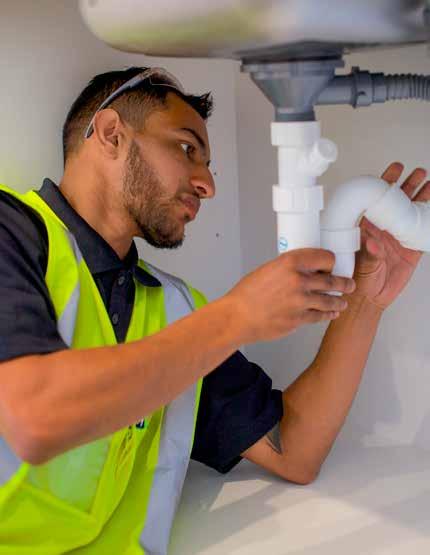
9 minute read
Call yourself a good driver?
Business sma r ts
CALL YOURSELF A GOOD DRIVER?
The Health & Safety at Work Act defines any vehicle used for business purposes as a ‘workplace’—which means unsafe driving can be risky for everyone involved. Over the page, NZ Plumber talks with Chris L’Ecluse of Teletrac Navman about driver safety and discovers how individual driver performance data can assist employers and their teams.
68 DRIVER SAFETY 70 PILLARS OF
WELLBEING 72 TOOLBOX TIPS
In his 20 years in the Western Australia Police force, among them as a crash investigator, Chris L’Ecluse saw first-hand the avoidable family tragedies that could result from unsafe driving. He went on to become a Master Driver Trainer and today works as a Solutions Specialist for Teletrac Navman, helping businesses develop policies, procedures and a workplace culture for safe driving.
Train your drivers: mitigate your risk Naturally, employers want to ensure their workers go home safe at the end of each day, but they also have a legal requirement to identify and mitigate safety risks.

Employers want their workers go home safe at the end of each day, and also have a legal requirement to identify and mitigate driver safety risks.
5 GOOD REASONS…
There are many good reasons to ensure you and your team drive well—beyond wanting to go home safely to your families each night. They include:
1.
2.
3.
4.
5. You could go to court if there’s a major incident and someone gets hurt or killed You could be fined if the collision was deemed to be preventable (as all collisions are) and due to not providing sufficient training If a field staff member loses their licence, it puts them out of action Vehicle damage can be costly and disruptive Your fleet insurance is likely to go up.

“If a driver has a collision while at work, and it results in serious injury or death, the matter will be investigated by WorkSafe and the police, and investigations will go up the chain of command,” says Chris. “Two questions will be asked of the employer in the dock—can you demonstrate what you have done proactively to: ■ identify the risk of driving? ■ mitigate the identified risk?
“By providing everyone in your business with driver training, you can show you have been proactive in mitigating the risks.”
Meaning of workplace
A vehicle, vessel, aircraft, shop, or other mobile structure
Health & Safety at Work Act, Section 20 (2) (a)
WHAT’S THE SCORE?
Businesses using the Teletrac Navman fleet management system can monitor driver performance across all their vehicles. This allows employers to see if their field staff are speeding, or braking, accelerating and cornering too harshly—factors that impact fuel usage and maintenance costs, as well as safety. Rather than using this punitively, businesses can encourage better driver behaviour by allowing their teams to access Driver Scorecards that show how they’re tracking in terms of driving performance and how they could do better. You could even consider incentivising staff with a regular competition for the best performing driver in the fleet.
A workplace culture of safe driving is particularly pertinent to plumbing businesses, where field staff are constantly on the move each day. “Plumbers are employed because they have an accredited qualification to practise their trade, and they undergo continuing professional development to help them carry out their work safely—and yet they are most likely to be harmed while driving to and from the job.” Driver risk profiles Most people believe they’re brilliant drivers, says Chris— but they have absolutely no data to back that up. “The beauty of Teletrac Navman telematics is that it gives employers a clear indication of how to prioritise the risk profile for individual drivers in the work environment. Without data, employers can only respond reactively—for example, after someone calls to complain about a team member’s driving, after that team member has received a police warning, or after an actual collision.”
Having established individual driver risk profiles, employers are able to change the team’s overall driving culture by arranging targeted training to help address individual driver shortfalls. ■ Two thirds of workplace fatalities happen in or around vehicles ■ Any vehicle used for work purposes constitutes a workplace. This includes personal vehicles used for work purposes, vehicles used by someone with a company fuelcard, and vehicles used by contractors. ■ Each work-related vehicle injury incident costs a company $15,300, according to a 2015 Ministry of Transport estimate.
D I d Y o u K n o w ?
Safety training: in the car or online? Teletrac Navman offers online driver safety modules that cover a range of topics, from driving in adverse conditions to driver fatigue, speeding, correct steering, vehicle checks, and how to react in an impending collision situation.
MOBILE PHONE USE
It's illegal to use a mobile phone while driving. You must be parked up and completely stationary in order to do so. Using a phone hands-free or via Bluetooth is legal as long as the user does not physically manipulate or hold the device while driving, and the device is contained in a commercial cradle. However, the law requires that a driver must commit 100% attention to the task of driving and not be distracted by anything not critical to performing this function—which includes talking on the phone. If the driver were involved in a collision and the police investigated, they would know from the call charge records that the driver was being distracted at the time of the incident, which would be considered as having contributed to the collision.
There are many other online driver safety training course options available to businesses, but Chris says he endorses the Teletrac Navman Driving Academy because it meets compliance requirements and is easy to navigate for those who aren’t particularly computer literate. Teamed with the telematics, it can also be targeted to specific areas where an individual needs improvement, rather than all staff having the same, blanket training.
The Teletrac Navman offering takes a ‘problem, proof, solution’ approach—with slides to show what the problem is, stats and graphs to demonstrate proof of the problem, and videos set in real-life New Zealand situations of how the problem can be avoided. Participants complete a quiz at the end of each module, with an 80% pass threshold to receive a certificate of completion.
Having taught defensive driver training for 10 years, Chris believes online training is preferable to sitting beside the driver in an actual vehicle as the barriers to learning can go up when a person feels their competence is being assessed. “The person also shows you their A game rather than their typical driving behaviour,” he says.
As well as being more cost effective than one-on-one sessions, online training can be spread out over time so as not to disrupt day-to-day business.
Teletrac Navman Solutions Specialist Chris L’Ecluse has a background in crash investigation, driver training and land transport safety consulting.
Do it all online. #9
With the PWGO app on your phone, you can order it anywhere.
wellbeing on tap
pillars of wellbeing
With the launch of the new Wellbeing on Tap wellbeing programme for the plumbing, gasfitting and drainlaying industry, mental fitness coach Sue Kohn-Taylor outlines the five pillars for positive wellbeing.
Nourish, Sleep, Active, Mind, Connect—why are these five words so important to you?
Because these areas of your life are the key to building positive wellbeing.
You may know that approximately one in five people will suffer from a mental illness in their life. However, if we build our life skills and build better mental fitness, it will help how we think, feel and act as we deal with life’s ups and downs.
The new Master Plumbers’ Wellbeing on Tap programme focuses on five pillars of wellbeing, outlined below, and here’s why they’re so important to you.
Nourish: Food has an amazing impact on our minds and our body. With more research showing us that food can affect our mental health, it makes sense to ensure we feed our brain in the best way possible. Simple changes can have a huge impact.
Sleep: A good night’s sleep is an essential ingredient to a healthy lifestyle, and a healthy mind. Make sleep a priority and learn the skills and tools on how to let your brain and body rest. Combine this with a balanced diet and regular exercise, and you will improve your physical and mental wellbeing, and set yourself up for a healthy and happy life.
Active: There are huge benefits in actively moving your body for emotional and mental health.
Physical activity can help greatly with maintaining positive mental wellbeing. The endorphins that the brain releases during exercise help to improve mood, energy levels and even sleep. Together, these positive effects help to improve self-confidence and resilience. Even a small boost of exercise makes a difference.
Mind: We talk a lot about physical fitness but what about mental fitness! Learning how to support a healthy mind is the driver of your life. When you have a strong, healthy mind, you have more ability to ride the ups and downs. You think better, react better and can make goals and plans for a happier and more fulfilling life.
Connect: There is strong evidence that shows that feeling close to, and valued by, other people is a fundamental human need and one that helps us function well in the world. We all need family and friendships where we know we are valued and cared for and can reach out and share when times are good and tough. Social relationships are critical for positive wellbeing and for acting as a
buffer against mental ill health for people of all ages. It’s also important to connect with the things you love doing—hobbies, passions, animals, nature. Connect with the things that fill you up as often as possible!
In my business I have worked with 1000s of people globally and what I have learnt about the core wellbeing pillars in Wellbeing on Tap is that, if you focus on making these an important part of your daily life in a positive way, you will feel a difference. My advice to you is, get in the driver’s seat, take responsibility for your wellbeing every day and know that you can be happier and more fulfilled.
About the author: Sue Kohn-Taylor is the passionate founder of The Mental Fitness Company, a regular on TV, column writer and speaker. She dedicates her time to teaching people how to build their mental fitness and resilience to enable them to lead a rewarding career and fulfilling personal life. TheMentalFitnessCompany.com.
Feeling under Pressure?










